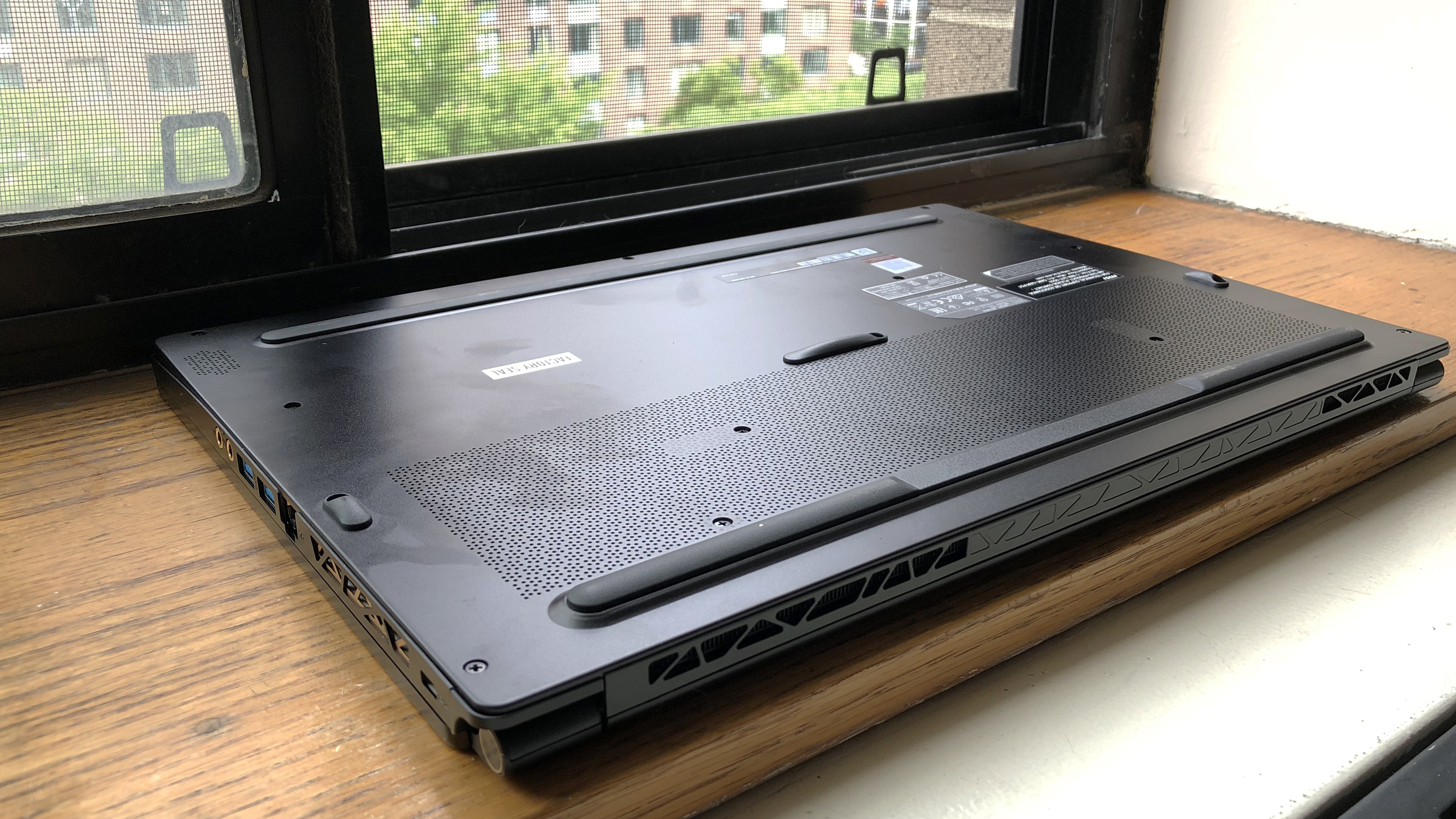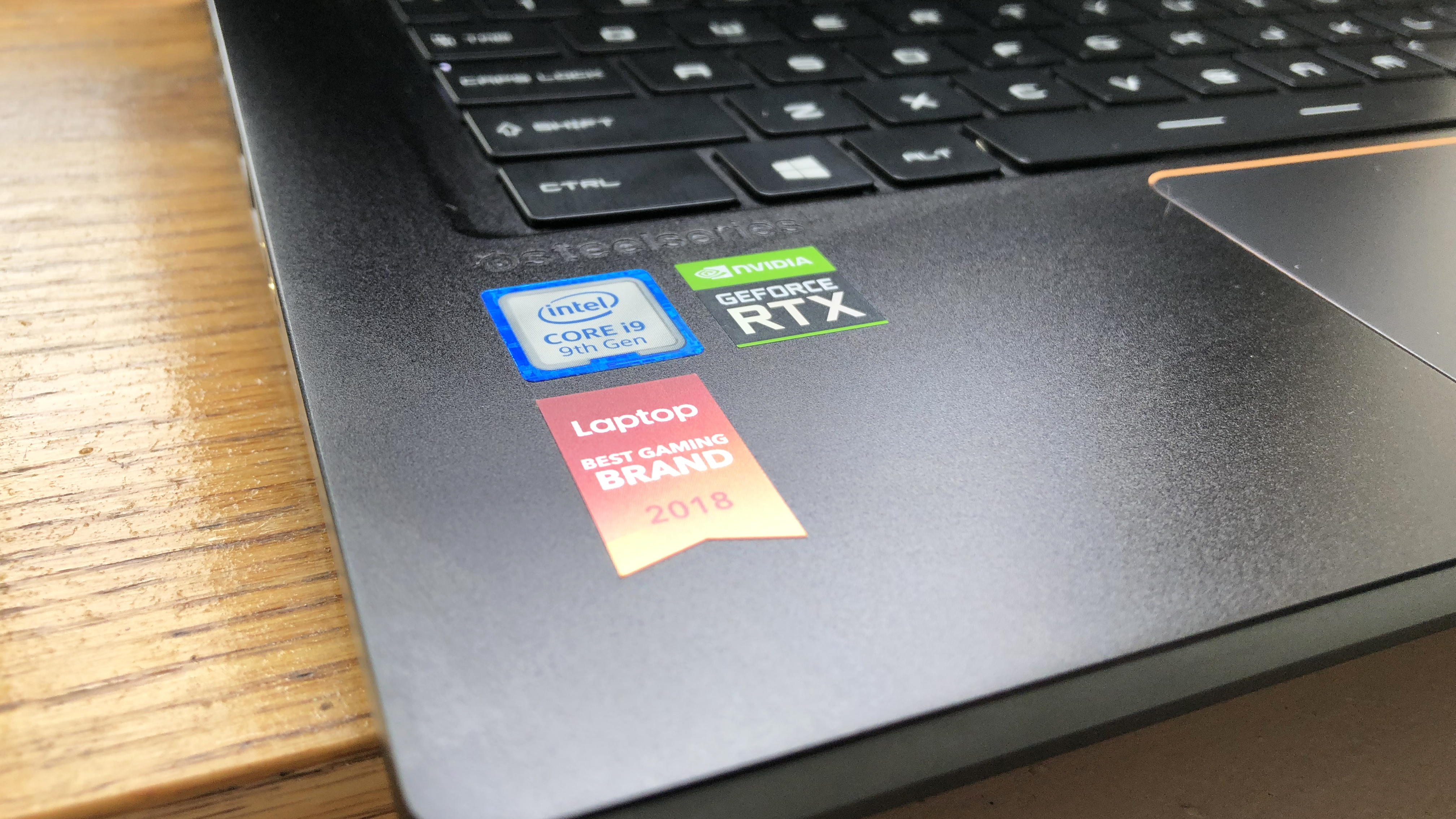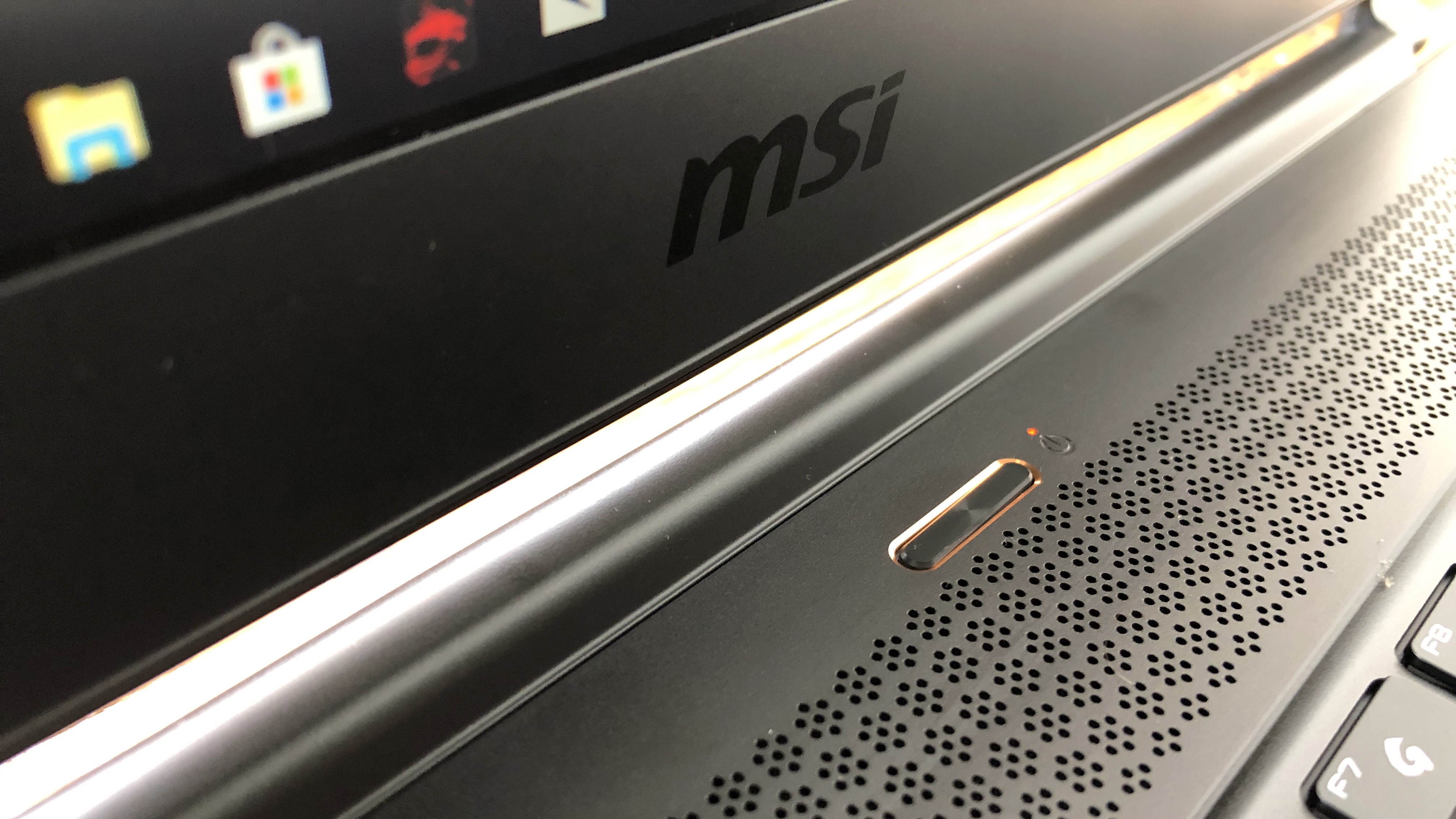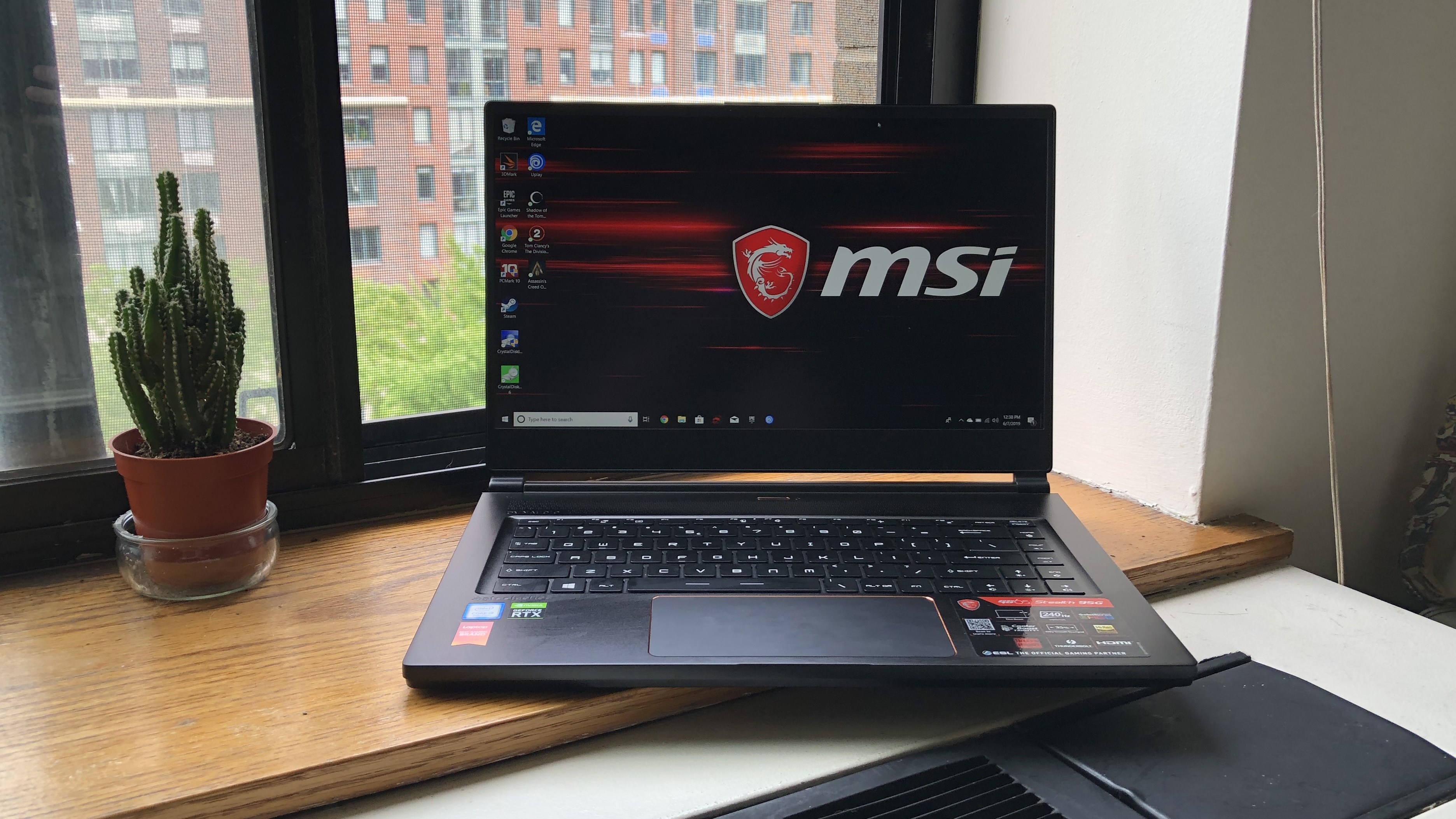Our Verdict
Seeing how it radiates wealth (it's literally a gold and black laptop), the MSI GS65 Stealth Thin could be a lot more expensive than it is. Somehow it tucks an Intel Core i9 processor, RTX 2080 graphics, 32GB of RAM and a huge 1TB hard drive into a sub-0.7-inch frame. Needless to say, I'm cheering it along.
For
- Refined, but still classy design
- Healthy range of specs and prices
- Outstanding performance
- Universal 240Hz refresh rate
Against
- 1080p resolution cap
- Hot hot heat
- Overly sensitive touchpad
- Norton Security bloatware
PC Gamer's got your back
Two years ago, Nvidia hatched a novel idea, begging the question, What if we took the guts of a gaming laptop and squeezed them into a MacBook Pro-like frame? Surely, others had entertained similar thoughts in the past. But to set itself apart, Nvidia actually invested the resources necessary to make it happen. Taking into account the overwhelming success of the Max-Q Design initiative, I'd say it paid off.
Though its conception has since led to valid concerns about thermal management, Max-Q is tucked into a significant number of the best gaming laptops on the market. Among them is the MSI GS65 Stealth Thin, an unusually sophisticated member of its dragon-emblazoned family. Painted black with gold accents, its color scheme alone is a welcome departure from the edgy crimson gamer's aesthetic of yesteryear. The rest of its design is just short of revolutionary.
Measuring 0.69 inches deep (nice), it is the thinnest Max-Q laptop we have ever reviewed. And, sporting a fun-size GeForce RTX 2080 and a 9th generation Intel Core i9-9880H, it is also the most powerful. But aside from that, and some minor improvements to the keyboard and touchpad, not much has changed since the last time we tested a GS65 Stealth Thin. It has the same dimensions, the same ports, and yet another G-Sync-deprived panel driving its juicy graphics. Though, to be fair, the refresh rate is now a blistering 240Hz.
Price: $3,399
Processor: Intel Core i9-9880H
Graphics: Nvidia GeForce RTX 2080 Max-Q 8GB
Memory: 32GB DDR4-2,666MHz
Display: 15.6-inch TN 240Hz
Resolution: 1920 x 1080
Storage: 1TB SSD
Battery: 82Wh
Connectivity: 1 x Thunderbolt 3 (USB-C), 3 x USB Type-A 3.2 Gen 2, Ethernet, HDMI 2.0, Mini-DisplayPort
OS: Windows 10 Pro 64-bit
Dimensions: 0.69 x 15.08 x 10.24 inches
Weight: 4.19 pounds
Warranty: One year
Nothing about the MSI GS65 Stealth Thin screams GAMING LAPTOP!!! straight into your ear canal. As such, it's one of the more flattering contributions to the genre. Its predominately black finish is festooned with lavish gold trimmings along the side, and a default keyboard glow to match. The touchpad, power button, and ears of the hinge have been treated to a modest helping of diamond-cut sheen as well. Its fans breathe through a gold and black vent.
For stealth gamers inhabiting coffee shops, playing Apex Legends, The Division 2, and Dauntless in secret, the GS65 Stealth Thin is a competent rival to the Razer Blade 15 Advanced Model. And as a huge middle finger to Razer, it's a full 0.09 inches thinner than the tri-snake company's self-proclaimed "world's smallest gaming laptop." Further sweetening the deal, the GS65 packs beefier components, including an Intel Core i9 processor, 32GB of RAM, and 1TB of NVMe SSD storage. To offset that cost, it commands a higher price tag. $3,399 for the model MSI sent me is enough to send my wallet up in flames.

There are cheaper options in MSI's catalog, however. For $2,999, the same price as the Razer Blade 15 I reviewed, you can have yourself a still-impressive Core i7/RTX 2080/32GB RAM/512GB SSD machine. Meanwhile, the $2,499 config bears a similar price point to the Acer Predator Triton 500. The entry-level, $1,998 version of the GS65 Stealth Thin houses an RTX 2060, an i7 processor, 16GB of RAM, and 512GB of storage. No matter which model best suits your budget, all possess 240Hz displays. All are 9th gen. For a high-end, flagship gaming laptop born in the age of Turing, this is a comfortable range of specs and prices.

Speaking of comfort, the keyboard, while only a mild improvement from its predecessor, does feel better for both typing and gaming. This time around, key travel is up from 1.4mm to 1.5mm. As our sister site LaptopMag often suggests, the ideal travel distance for a keyboard is between 1.5 and 2mm. At long last, the MSI GS65 Stealth Thin falls within that threshold. The keyboard supports per-key RGB lighting by way of the built-in SteelSeries Engine 3. Other pre-installed software includes MSI True Color, MSI Dragon Center, and the ever-uninvited Norton Security.
The touchpad, too, has experienced growth. It's 35 percent bigger than last time, according to MSI, and that's no small change. Now comparable in size to that of the 17-inch GS75 Stealth, the touchpad almost serves as a perfect silhouette of my iPhone X.

Also like the GS75 Stealth, the touchpad on the GS65 Stealth Thin is fickle. Even when I'm not trying to engage, it sometimes registers my light palm contact as a palpable gesture. I've never had this problem with a MacBook or with the Razer Blade. Most gaming laptops, for that matter, do not position the touchpad this close to the keyboard deck. When you are playing games, you'll want to shell out an additional lump of cash for the best gaming mouse. Once you do, I would disable the touchpad altogether, lest you run into the same unintentional cursor movements that I did.
Contrary to what other reviewers have said, the bottom-mounted speakers on the MSI GS65 Stealth Thin did not blow me away. In fact, they sounded flat, especially at louder volumes. I don't know what the range is on these things, but I can hardly distinguish the mids from the lows and so forth.

The screen is another story altogether. Whereas I expected typical TN quality from a so-called "IPS-level" display, the screen is almost as vibrant from the side as it is looking straight on. Still, there is an RTX 2080 driving its 1080p display, which seems like overkill, even if has a 240Hz refresh rate. Some of us care more about resolution than refresh rate. I'd rather have a 1440p 60Hz display, as my underclocked eyes can hardly tell the difference between 60fps and 240fps. Either I need a new prescription or high refresh rate panels are little more than a cheap marketing ploy.
Performance and Verdict: Should I buy the MSI GS65 Stealth Thin?
Given its extravagant innards, it should come as no surprise that the MSI GS65 Stealth Thin excelled in our suite of benchmark tests. In Metro Exodus, at the most intense RTX setting (with ray-tracing cranked all the way up to High), it blew the Razer Blade 15 Advanced Model out of the water, netting an average of 62fps — a full 22 percent higher than the Blade 15's 51fps tumble.

As for non-ray-traced games, aka most of them, the differences weren't as monumental. The GS65 garnered a 71fps average in The Division 2 at Ultra settings, with a 69fps score in the Total War: Warhammer II Battle benchmark. In 3DMark Fire Strike, it brought home 16,741 points. To put this in perspective, here's how the Razer Blade 15 Advanced Model performed in those same tests:
- Tom Clancy's The Division 2: 75fps (5.6 percent higher)
- Total War: Warhammer II: 79fps (14.5 percent higher)
- 3DMark Fire Strike: 15,889 points (5.1 percent lower)
As you can see, the difference between these two laptops is marginal in The Division 2, despite the GS65's faster CPU and more capacious RAM. In Total War: Warhammer II, the Razer Blade 15 performed notably better than the GS65 Stealth Thin. In 3DMark Fire Strike, the de facto DirectX 11 bench, the GS65 Stealth Thin took home the crown.
Battery life is harder to contextualize. Before this review, we would run a Twitch stream on every laptop we reviewed until the system died. Because of the sheer number of variables in that assessment, I've decided to switch us over to the consistent and standardized PCMark 10 battery life test from UL, which just released last week. Simulating "a range of of common scenarios," like writing, web browsing and video conferencing, I felt as though the Modern Office test would best mimic real-world use cases, so I tried that one.
At 4 hours and 25 minutes, the MSI GS65 Stealth Thin reached its fatal demise. Compare that to the 5 hours and 1 minute endured by the Razer Blade 15 in our previous, dodgier Twitch stream test and I'd say it stacks up fine against the gaming laptop norm. Maybe someday, with the advent of Ice Lake and Project Athena, we'll start seeing battery life take priority over some of the superfluous embellishments. Until then, four and half hours is par for the course, unfortunately.
Cinebench R15: 3,383cb (single-core); 412cb (multi-core)
CrystalDiskMark Q32 Sequential (Read): 3,241.5MB/s
CrystalDiskMark Q32 Sequential (Write): 2,396.1MB/s
PCMark 10: 5,450 points
Tom Clancy's The Division 2: 71fps
Total War: Warhammer II (built-in benchmark): 69fps
Metro Exodus (built-in RTX benchmark): 62fps
3DMark Fire Strike: 16,741 points
PCMark 10 Battery Life: 4 hours 25 minutes
MSI has crafted yet another win for itself with the GS65 Stealth Thin. Although it doesn't stray far from the precedent it set last year, it really didn't need to. I liked it as it was, and I like it even more now. It is expensive, yes, and you might call me a hypocrite for criticizing other laptop makers for price gouging while letting MSI off scot-free. But considering its elegant looks, premium build quality, and powerful components, the MSI GS65 Stealth Thin isn't what I would call overpriced.

That said, it isn't perfect. It does heat up in my bag when I put it into sleep mode, and while I would never use a gaming laptop in my lap, that does mean it could leave slight burns should you bring it into contact against your bare skin. Moreover, the built-in Norton Security software needs to stop. Seriously, if I have to see another reminder that my laptop is at risk, I will throw it out a window. And as I mentioned earlier, the touchpad can be unreliable at times due to its misguided placement.
Rather than focusing purely on value, the MSI GS65 Stealth Thin takes a different approach, outfitting an already brilliant chassis design with best-in-class performance for the first time in company history.
Seeing how it radiates wealth (it's literally a gold and black laptop), the MSI GS65 Stealth Thin could be a lot more expensive than it is. Somehow it tucks an Intel Core i9 processor, RTX 2080 graphics, 32GB of RAM and a huge 1TB hard drive into a sub-0.7-inch frame. Needless to say, I'm cheering it along.



